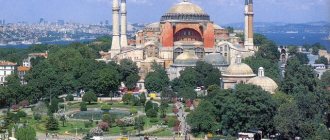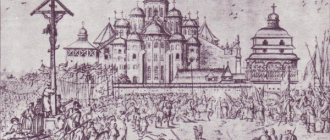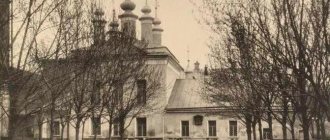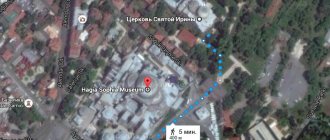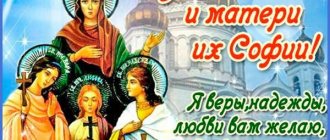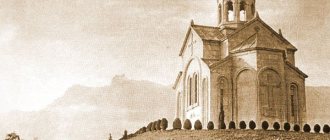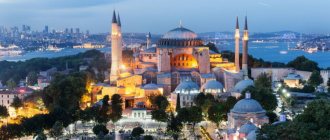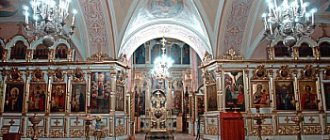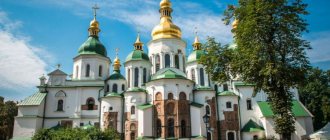Ukraine
Saint Sophie Cathedral
Saint Sophia Cathedral
— The Cathedral Church of the Kyiv Metropolis since the 11th century, one of the most famous shrines of Rus'. A world-famous masterpiece of medieval Christian culture and art.
In 1990, the St. Sophia Cathedral, like the Kiev Pechersk Lavra, became the first architectural monument on the territory of Ukraine to be included in the UNESCO World Heritage List.
Since the cathedral building is part of the Sophia of Kiev National Reserve and is included in the UNESCO World Heritage List, it is prohibited to transfer it to any religious organization and to hold services in it. An exception is the day of August 24 - Independence Day of Ukraine, when representatives of religious organizations pray for Ukraine (introduced since 2005); On November 22, 2006, the Holy Synod of the Ukrainian Orthodox Church (Moscow Patriarchate) declared that it was impossible for itself to participate in such events.
Historical excursion[edit]
The idea to build “the Church of St. Sophia, the metropolis” in Kyiv, according to Metropolitan Hilarion, belonged to Vladimir Svyatoslavich, but it was already Yaroslav the Wise who had the opportunity to implement it. The date of the foundation of the cathedral over one and a half centuries is the subject of scientific debate. Taking into account all historical circumstances, the most probable years of construction should be considered 1032-37. - exactly 500 years after Sophia of Constantinople, which was a symbolic model for the Kyiv temple.
Saint Sophia Cathedral. Drawing by A. van Westerfeld. 1651
According to ancient church tradition, Sophia of Kyiv was founded by Metropolitan John, and consecrated by his successor Theopempt. The unknown architects were representatives of the capital's Constantinople school of architecture. The temple is dedicated to Sophia - the Wisdom of God. This is one of the most complex abstract categories of Christian theology, which has many interpretations. According to the Apostle Paul, Sophia symbolically corresponds to the hypostasis of Christ - the incarnate Word of God. Only later, when the identification of Sophia with the Mother of God spread, the temple holiday of the Kyiv Cathedral was moved to September 8 (21) - the day of the Nativity of the Virgin Mary. The artistic image of the St. Sophia Cathedral was supposed to embody the multifaceted meaning embedded in this symbol. This explains its enormous size and extremely complicated structure. In general, the interior of Sofia reproduces the medieval model of the Universe, and the exterior - the image of the City of God - Heavenly Jerusalem.
Like other temples, Sofia was the burial place of prominent personalities, mostly wealthy. The necropolis of St. Sophia Cathedral began to take shape in the middle of the 11th century. During his lifetime, the founder of the temple ordered that a tomb be built for himself in the northern gallery. The sarcophagus of Yaroslav the Wise is still preserved in the cathedral. According to the chronicle, four more burial places of princes, Yaroslav’s descendants, are known in Sofia, as well as the burial places of many Kyiv metropolitans.
In pre-Mongol times, St. Sophia Cathedral was plundered twice. For the first time this was done by the troops of Andrei Bogolyubsky and his allies in 1169, and the second time by the squads of Rurik Rostislavich in 1203. The temple also suffered from a great fire in 1180.
Sofia and the Sofia courtyard suffered the greatest damage during the Mongol invasion of 1240, as well as the Tatar raids of 1416 and 1482. However, the temple was not destroyed and continued to operate. Already in 1273, Metropolitan Kirill convened a local council of the Russian Church here. And although after 1300 the Kyiv metropolitans visited their devastated residence less and less, certain restoration work was carried out from time to time. In particular, in 1376-78. The renovation of Sofia was carried out by Metropolitan Cyprian, and around 1577 by the Metropolitan's deputy Bogush Gulkevich-Glebovsky.
Main altar of St. Sophia Cathedral
Despite these efforts, the temple gradually fell into disrepair. This happened mainly due to the indifference and selfishness of the metropolitan officials. At the end of the 16th century. St. Sofia was such a sad sight that it caused indignation even among the Catholic Bishop Joseph Vereshchinsky. In 1608, the Uniates took possession of the St. Sophia Cathedral and continued to steal construction materials, in particular roofing, for sale. The rest was completed by rain and wind.
On July 2, 1633, the newly elected Orthodox Metropolitan Peter Mogila liberated St. Sophia Cathedral from the power of the Uniates and founded a monastery with it. A major restoration of the temple began in 1634, but during Mogila’s lifetime it was never completed. In particular, the western gallery remained dilapidated. In 1637-38. the work was led by the Italian architect Octaviano Mancini. Obviously, it was he who gave the facades of the cathedral a Renaissance character, known to us from the drawing of Abraham van Westerfeld in 1651. At the same time, a new carved iconostasis and two altar chapels were built in the external galleries.
In 1688, Metropolitan Gideon Svyatopolk-Chetvertinsky, with donations from the Moscow kings, began a new, more significant reconstruction of St. Sophia. At this time, second floors were built above the external galleries, six new domes and eight Baroque pediments were built, hiding the original small domes. The work was supervised by apprentice mason Savva Yakovlev. They were completed by 1695, as evidenced by the image on Ushakov’s plan.
The newly rebuilt cathedral was severely damaged by a fire in 1697 and needed new restoration. In 1699-1706. it was carried out by Metropolitan Varlaam Yasinsky at the expense of Hetman Ivan Mazepa. It was at this time that the ancient mosaics and frescoes were whitewashed, the remains of the western gallery and the western triple arcade with part of the choirs were dismantled, the building was strengthened on all sides with powerful buttresses.
In 1718-24. A new baroque mural was completed in 1739–47. Metropolitan Rafail Zaborovsky carried out another restoration of the cathedral, and in 1747-54. A three-tier iconostasis was built, the lower tier of which has survived to this day. At the beginning of the 19th century. the cathedral had 17 thrones.
The scientific study of Sophia of Kiev began with the book of Metropolitan Evgeniy Bolkhovitinov, “Description of the Kiev-Sophia Cathedral,” published in 1825. However, the real sensation was the accidental discovery of ancient frescoes in 1843. During 1843-53, simultaneously with the barbaric “updating” of the murals , the architect Pavel Sparro carried out a thorough renovation of the temple, during which the roof was replaced, the floor was paved with cast-iron slabs and the upper tier of the iconostasis was removed, which prevented one from seeing the mosaics of the altar.
During the last reconstruction, carried out in 1882-89. under the leadership of Vladimir Nikolaev, part of the baroque pediments were dismantled and ancient small domes were opened. The cross-shaped window in the center of the western façade was cut out, and in place of the western gallery, the existing narthex in the pseudo-Byzantine style was built. At the same time, under the floor of the cathedral, the air-heating channels were tripled and another tier of the iconostasis was removed.
In October 1921, a council was held in the St. Sophia Church, at which the creation of the Ukrainian Autocephalous Orthodox Church was announced. St. Sophia belonged to the UAOC until its liquidation in 1930. In 1934, the service of God in the cathedral was stopped and the State Architectural and Historical Reserve “Sofia Museum” was formed. The activity of the reserve began with vandalism: during 1935-37. eight baroque iconostases of side altars made by Ukrainian masters of the 17th-18th centuries were dismantled and mostly burned. The gilded silver royal doors of 1747 also disappeared from the main iconostasis. At the same time, the creation of the reserve made it possible for the first time to conduct research and restoration of the monument on a truly scientific basis.
According to the former head of the Sofia Nature Reserve, Alexei Povstenko, in September 1941, the Soviet military attempted to mine the temple, but, fortunately, it was unsuccessful. In the post-war years, the St. Sophia Cathedral was regularly restored and studied. Its premises maintain a microclimate favorable for the preservation of priceless works of medieval art.
In 1990, the St. Sophia Cathedral, like the Kiev Pechersk Lavra, became the first architectural monument on the territory of Ukraine to be included in the UNESCO World Heritage List.
Stone Chronicle
The founder of the cathedral was Prince Yaroslav the Wise , during whose reign Russia was considered the most educated state in Europe. Not only noble citizens, but also ordinary people knew literacy, read and wrote. The prince said: “Great benefits come to a person from book learning.”
In 1037, at the site of the battle between the Kyivans and the Pechenegs, in honor of the victory of the Russian soldiers, the prince ordered the foundation of the stone church of St. Sophia. Translated from Greek, the name “Sophia” means “wise,” so the dedication of the temple to St. Sophia was perceived as a symbol of Christian wisdom, a sign of the victory of Orthodoxy over paganism. The temple, built during the heyday of Kievan Rus, eclipsed everything that was created in Russian soil in previous eras.
The intelligent and inquisitive Yaroslav the Wise turned the religious temple into the cultural and socio-political center of the Old Russian state. The St. Sophia Church in Kyiv is a center for chronicling, copying and translating books and the first library in Rus', a witness to Kyiv veche, the reception of foreign ambassadors and the ceremonies of “seating” princes on the Kiev throne.
Description[edit]
Kiev St. Sophia Cathedral was one of the largest buildings of its time. The total width of the temple is 54.6 m, length - 41.7 m, height to the zenith of the central dome - 28.6 m. The cathedral has five naves, completed in the east with apses, crowned with 13 domes forming a pyramidal silhouette, and is surrounded by three sides with two rows of open galleries, of which the inner one has two tiers. For a long time it was believed that the galleries were added to the cathedral later, but recent research has proven that they are connected with it by a single design and arose simultaneously. Only the baptistery, built into the western gallery, dates back to the mid-12th century.
Plan of Sophia of Kyiv
The spatial solution of the central core is cross-domed. It is surrounded on three sides by extremely spacious choirs, opening into the temple with triple arcades. Obviously, the choirs were intended not only for the presence of the princely family during divine services, but also to house the main institutions of the Kyiv Metropolis - a chamber for ceremonial events, a library with a scriptorium (a workshop for the production of handwritten books), an office, and a treasury. To ascend to the choir, two towers with spiral staircases are built into the western gallery.
Sophia of Kiev is a perfect example of a synthesis of arts. The mural painting and decorative decoration form an indivisible whole with the architecture of the temple. In the Kiev Cathedral, a combination of mosaics with frescoes in one interior, unusual for Byzantium, was used. At the same time, mosaic images cover only the most important parts of the temple - the main altar and the central dome; the rest of the interior is decorated with fresco murals. Remains of frescoes were also found on the facades - in niches and on gallery pillars.
The floor in the altar and the central part (chorus) was laid with slate slabs inlaid with mosaics, and in other parts - with ceramic tiles. Many design elements were carved from imported Greek marble. The thresholds and columns, the low pre-altar fence-templon and the canopy-ciborium above the throne were marble. The slate parapets of the choir fence are covered with carved ornaments.
An outstanding historical source is the complex of graffiti inscriptions scratched on the walls of the cathedral by its visitors over the centuries. Among them there are autographs of famous historical figures of medieval Rus'.
Interior of the cathedral
Initially, the altar and dome of the cathedral were decorated with picturesque colored mosaics. The remaining parts of the interior were decorated with frescoes. A mosaic painting of Christ and 4 archangels is located in the very center of the dome. Many fragments were lost, only the archangel in blue clothes remained genuine. The rest in the 19th century. were completed with paints by the artist Vrubel. The dome's sails are painted with images of saints writing the Gospel. Above, on the drum windows, there were 12 apostles. Currently, you can see the upper part of the body of Apostle Paul, dating from the 11th century. Above the altar on the vault is a mosaic of Our Lady of the Unbreakable Wall.
The walls of the cathedral are painted with frescoes with stories from the lives of saints. Also, the walls of the temple have many preserved graffiti, from which historians learn interesting facts about the ancient life of the cathedral. Especially valuable are the graffiti of Sofia of Kyiv.
Shrines[edit]
- In the St. Sophia Cathedral in Kyiv, under the arch of the high place, there is a mosaic image of the Virgin Mary, which received the name “Unbreakable Wall”. The Mother of God is depicted in full height with raised arms, standing on a golden quadrangular stone. Along the arc of the semi-vault, in black mosaic, there is an inscription in Greek: “ὁ Θεὸς ἐν μέσῳ αὐτῆς καὶ οὐ σαλευθήσεται · βοηθήσει αὐτ ῇ ὁ Θεὸς τὸ πρὸς πρωΐ πρωΐ. “God is in her midst and does not move: God will help her in the morning.” (Ps. 45:6). The icon probably received its name due to the fact that for more than 800 years, the wall with this mosaic was never destroyed, unlike the rest of the cathedral. In honor of the icon, a convent was founded in 2001 in the city of Apsheronsk.
- Icon of the Mother of God Sophia - Wisdom of God (Kiev)
. This icon, borrowed from the Church of Justinian in Byzantium, depicts the union of the Heavenly and Earthly Churches through the incarnation of the Son of God - the Wisdom of God.
Pilgrim[edit]
Since the cathedral building is part of the Sophia of Kiev National Reserve and is included in the UNESCO World Heritage List, it is prohibited to transfer it to any religious organization and to hold services in it.
However, Sophia of Kiev, as before, attracts an endless stream of pilgrims and tourists from all over Ukraine and from foreign countries. Every year, the Sofia Kyiv Nature Reserve is visited by about two million people who seek to get acquainted with the wonderful creation of world culture.
Working hours
Cathedral: 10:00 - 17.30 (Wed. - until 16:30)
Day off:
Thursday
